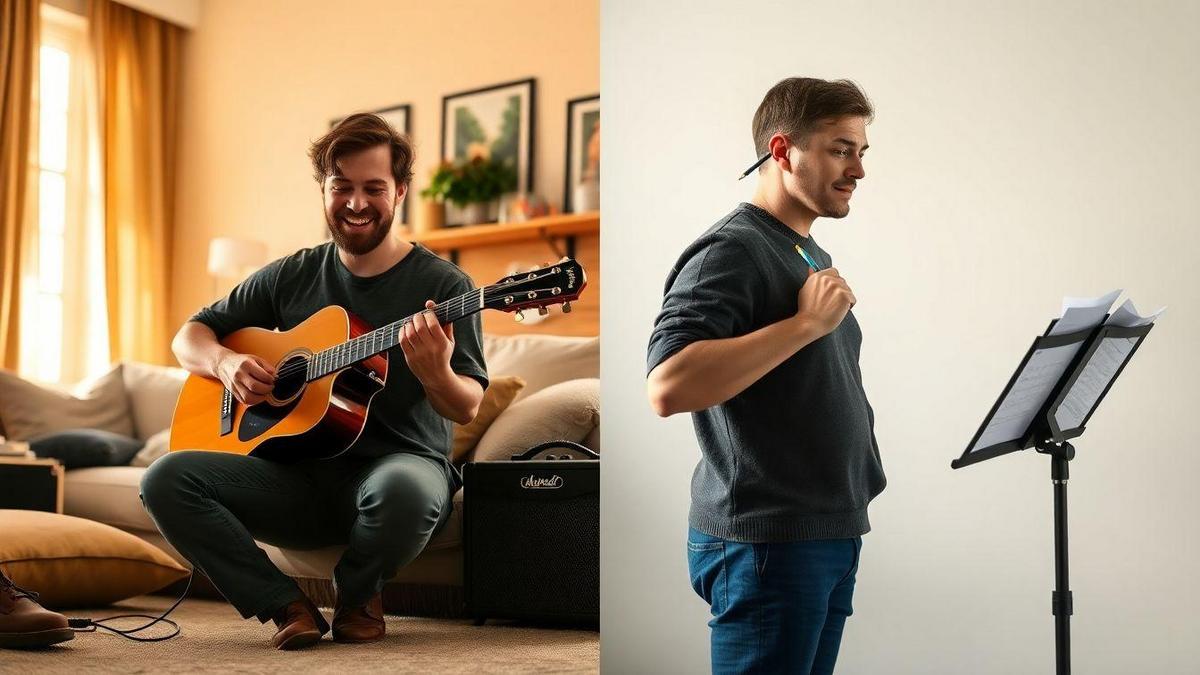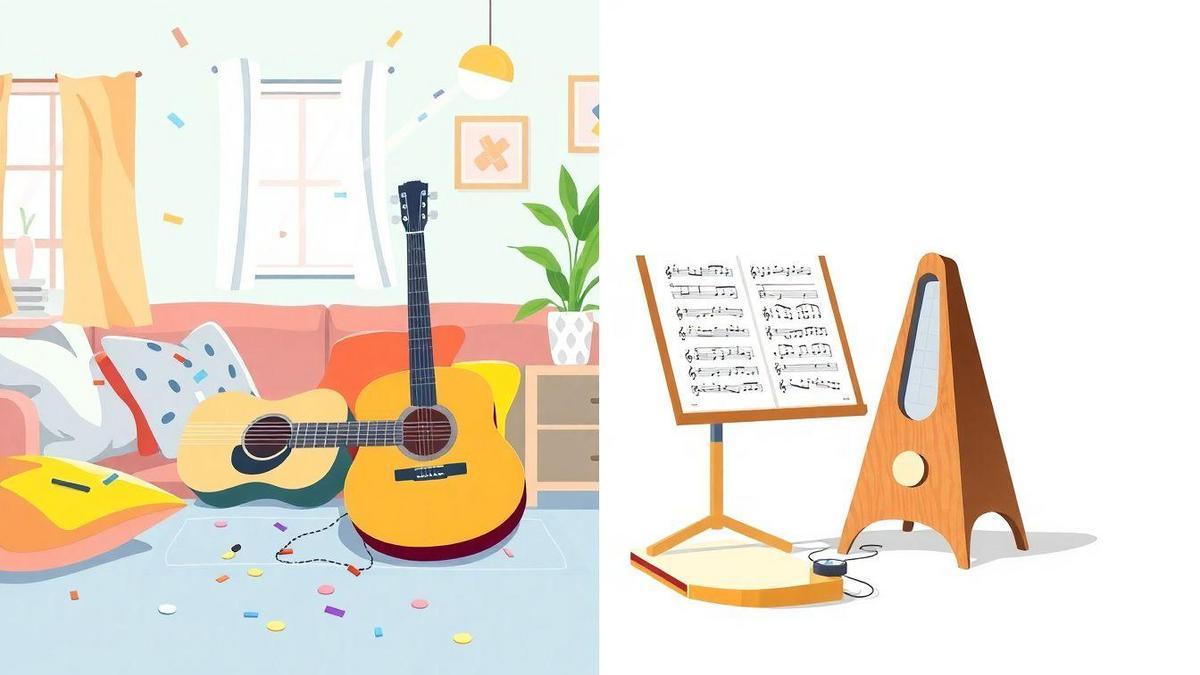The difference between playing and practicing (and why it matters)
I break down the difference between playing and practicing in plain words: what each mode means, how goals change the work, a focused-practice vs casual-play example, simple routines, a repeatable 20-minute template, motivation tricks, progress measurement, common mistakes, useful tools (metronome, recordings), and how musicians build lasting habits.
Key takeaway
- Playing = fun; practicing = improvement.
- Practice needs a plan; play is free.
- Fix mistakes, repeat small parts, and track progress during practice.
- Balance deliberate practice with free play to keep joy and steady gains.
I break down the difference between playing and practicing in plain words: what each mode means, how goals change the work, a focused-practice vs casual-play example, simple routines, a repeatable 20-minute template, motivation tricks, progress measurement, common mistakes, useful tools (metronome, recordings), and how musicians build lasting habits.

What playing vs practicing means
- Playing: pick up your instrument to enjoy, improvise, and explore. No strict goals, mistakes are OK. See ways to make spontaneous music more approachable with a guide to beginner-friendly improvisation.
- Practicing: work on a specific skill—slow, repeat, fix, and measure. Improvement is the aim.
Think of playing as the party and practicing as the workout. Both are valuable; they just serve different purposes.
How goals change everything
When the goal is fun:
- Play songs you love, jam, improvise without pressure—remember that playing also supports wellbeing; read about how music can clear the mind.
When the goal is progress:
- Choose one small skill (riff, rhythm, fingering).
- Set a clear target: e.g., clean 8 bars at 90% speed.
- Repeat, check, adjust, repeat.
If you want to improve, pick focused practice; if you want to relax, choose casual play. This is the core of understanding The difference between playing and practicing (and why it matters).
Focused practice vs casual play — a short example
Focused practice:
- 10 minutes on one tricky bar.
- Slow to 60% speed, use a metronome (learn gentle strategies to use a click without losing patience: metronome tips).
- Do 5 clean reps, stop to fix one tiny error, repeat.
Casual play:
- Play through three favorite songs, sing and improvise.
- Laugh at mistakes, keep momentum.
Focused practice chisels skill; casual play paints creativity. You need both.
Benefits: deliberate practice vs free play
Deliberate practice gains:
- Faster accuracy, cleaner timing, wider range, better problem spotting, quicker learning, stronger memory, stage confidence, measurable progress.
Free play gains:
- Flow, new ideas, emotional release, social warmth, low-stakes risk, stylistic discovery.
Knowing The difference between playing and practicing (and why it matters) helped me split sessions: focused drills then free play. Progress and joy both increased. For public-health guidance on playing and wellbeing, see How music supports mental wellbeing.
What research says
- Ericsson et al. (1993): focused, goal-directed practice helps reach high skill.
- Macnamara, Hambrick & Oswald (2014): practice explains a meaningful slice of performance differences, but not everything.
- Later reviews: practice is a strong predictor across domains; other factors (age, coaching, talent) also matter—see a discussion of talent versus practice and why consistency often beats raw talent.
My takeaway: practice matters a lot — especially when it’s smart and combined with play. For a concise summary of the core studies and ideas, see this Overview of deliberate practice research.
Simple, repeatable practice routine
Treat practice like a short workout. Keep sessions short and focused.
Principles:
- One clear goal per session.
- Short sessions (10–20 minutes) keep attention high—if you want a ready plan, try a simple daily practice routine.
- Warm up briefly, focus on the hardest part, then test in context.
- Always end with a bit of play to stay motivated.
Example session flow:
- Warm-up — 2 minutes (finger stretches, simple runs).
- Drills — 4–6 minutes (scale or rhythm pattern).
- Slow work — 6–8 minutes (chunk the hardest bars, loop at slow tempo).
- Song time — 4–6 minutes (play through or jam as reward).
- Note one line: Next time: and the next small step.
ABRSM also provides clear options for structured practice; see Practical step-by-step practice guidance from ABRSM.
A repeatable 20-minute template
- Warm-up — 2 min.
- Drills — 6 min (one scale/rhythm).
- Slow work — 8 min (hardest 4 bars in 2-bar chunks at 50% tempo).
- Song time — 4 min (play full song or favorite section).
After: jot What worked? and Next time.
This template helps you start fast and avoid aimless sessions. For a focused 20-minute approach and how to build it into daily life, see the power of just twenty minutes.
Keep motivation high
- Set one clear goal per session.
- Reward yourself (coffee, a 5-minute jam) after a focused stretch.
- Mix play and practice: start with 5–10 minutes of free play, do focused drills, end with song time.
- Track small wins weekly to build momentum—strategies for staying motivated when progress feels slow are useful: motivation tips.
Habit tips: place gear in plain sight, practice after a reliable cue (post-coffee, pre-dinner), and start tiny (2–10 minutes). Rituals that make it easier to begin are described in practice-entry rituals. If procrastination is a problem, try approaches from overcoming procrastination. To keep practice enjoyable, see ideas for making practice fun. For additional methods from contemporary-music educators, read Strategies for motivated, focused practice.
Measure progress efficiently
Track three simple metrics each session:
- Tempo (BPM) practiced.
- Error count in the excerpt.
- Time practiced (focused minutes only).
Recording is crucial:
- Record the same excerpt weekly for comparison—keeping notes can be made easier with a practice log; consider whether you want to keep a practice journal.
- Listen with fresh ears later and note two strengths two fixes.
- Use recordings to confirm improvement and guide next steps.
Compare accuracy, speed, and musicality over time. Prioritize clean at slow tempo; increase speed only when errors drop. BBC Bitesize has clear, simple suggestions if you want extra structure: Simple methods to track practice progress.
Tools that help
- Metronome: enforces consistency; raise tempo only after clean reps — find patient metronome strategies at how to use a metronome.
- Tuner: check pitch before sessions.
- Recorder/phone: objective feedback; spot mistakes you miss while playing.
- Apps: choose ones that track reps, timers, and progress graphs — avoid distractions.
- Visual tools: waveforms, pitch graphs, loop-and-slow features help locate problem spots.
Use these tools to translate the strategy into measurable moves — a key to understanding The difference between playing and practicing (and why it matters).
Fixing common mistakes
Stop these traps:
- Mindless repetition without change.
- Only playing songs with no targeted goals.
- Skipping slow work and rushing to speed.
- Ignoring feedback.
How to fix:
- Isolate 2–4 measures, slow to a tempo where it’s clean, loop until three clean repetitions, then nudge tempo up 5–10%.
- Record takes and use a teacher or reliable recordings for honest feedback.
For common beginner pitfalls and how to avoid them, see a list of seven mistakes that slow progress and a practical guide on turning mistakes into learning opportunities.
Practical steps for musicians
- Label time as practice or play and write the goal for each block.
- Break songs into 2–4 bar chunks and practice the hardest beat first.
- Train technique, rhythm, and ear separately in mini-blocks: technique first, rhythm next, ear work last.
- Use slow practice, scales, and etudes to build lasting control.
Remember: practice fixes weak spots; play keeps the music alive. If you’re unsure how much daily time helps near-term improvement, consider guidance on how much time per day to practice.
Build long-term habits
- Habit-stack practice to daily cues.
- Start tiny and scale up gradually.
- Adjust your routine when you plateau or reach new goals: change one drill at a time, keep one fun segment.
- Weekly review (10 minutes): list three wins, one challenge, one focus for next week.
This keeps practice sustainable and aligned with growth — and ritual ideas can make starting automatic (see practice rituals).
Conclusion
The difference between playing and practicing (and why it matters) is simple but powerful: playing brings joy and exploration; practicing builds skill and reliability. Label your time, set a clear goal, fix one tiny mistake at a time, and repeat with purpose. Short, focused reps plus a touch of free play carve skill faster than long, aimless hours — and keep music worth playing.
For more short, usable routines, tips, and templates, visit simple practice routines and the guide on 20-minute daily practice.
Frequently asked questions
Q: How do I tell playing from practicing?
A: Ask if you have a clear goal. If not, you’re probably playing. Practicing has a target and a plan to fix errors.
Q: The difference between playing and practicing (and why it matters)?
A: Playing = relaxation and exploration. Practicing = focused, measurable improvement. Knowing which you’re doing helps you spend time productively.
Q: How can I make practice feel like play but still work?
A: Break goals into tiny steps, use short rounds, and reward yourself with a few minutes of free play after focused work. Add playful challenges (non-dominant hand, sing while you play) to keep it fun. For creative ways to blend fun and structure, see making practice fun.
